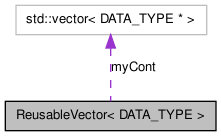ReusableVector< DATA_TYPE > Class Template Reference
Create a vector of DATA_TYPE that reuses created objects to save on memory reallocations. More...
#include <ReusableVector.h>
Collaboration diagram for ReusableVector< DATA_TYPE >:

Public Member Functions | |
| void | reset () |
| Clear the vector contents. | |
| void | clear () |
| Clear the vector contents. | |
| DATA_TYPE & | getNextEmpty () |
| Get a reference to a new entry to be populated so the user can directly populate it rather than having to copy into it. | |
| DATA_TYPE & | get (unsigned int index) |
| Get a reference to the data at the specified index. | |
| int | size () const |
| Return the number of populated entries in the vector. | |
| void | rmLast () |
Protected Attributes | |
| std::vector< DATA_TYPE * > | myCont |
| unsigned int | myNextEmpty |
Detailed Description
template<class DATA_TYPE>
class ReusableVector< DATA_TYPE >
Create a vector of DATA_TYPE that reuses created objects to save on memory reallocations.
DATA_TYPE must have a function called clear() that is used to reset it for reuse.
Definition at line 30 of file ReusableVector.h.
Member Function Documentation
template<class DATA_TYPE >
| DATA_TYPE & ReusableVector< DATA_TYPE >::get | ( | unsigned int | index | ) | [inline] |
Get a reference to the data at the specified index.
Throws an exception if the index is out of range.
Definition at line 117 of file ReusableVector.h.
00118 { 00119 if((index < myNextEmpty) && (index >= 0)) 00120 { 00121 // index is a valid position, so return that data. 00122 if(myCont[index] == NULL) 00123 { 00124 throw(std::runtime_error("ReusableVector::get BUG, found a null pointer.")); 00125 } 00126 return(*myCont[index]); 00127 } 00128 00129 // Not set in the vector, so throw an exception. 00130 throw(std::runtime_error("ReusableVector::get called with out of range index.")); 00131 // return(myCont[0]); 00132 }
template<class DATA_TYPE >
| DATA_TYPE & ReusableVector< DATA_TYPE >::getNextEmpty | ( | ) | [inline] |
Get a reference to a new entry to be populated so the user can directly populate it rather than having to copy into it.
Definition at line 90 of file ReusableVector.h.
00091 { 00092 if(myNextEmpty == myCont.size()) 00093 { 00094 // We are at the end of the available entries, so add a new one. 00095 myCont.resize(myCont.size() + 1); 00096 00097 // Create a new entry. 00098 myCont[myNextEmpty] = new DATA_TYPE; 00099 } 00100 else 00101 { 00102 // myNextEmpty is an element, and not the end. 00103 // So, clear out the data. 00104 myCont[myNextEmpty]->clear(); 00105 } 00106 00107 DATA_TYPE* returnVal = myCont[myNextEmpty]; 00108 00109 // Increment next empty to the next element. 00110 ++myNextEmpty; 00111 // return the element to be used. 00112 return(*returnVal); 00113 }
The documentation for this class was generated from the following file:
- general/ReusableVector.h
 1.6.3
1.6.3